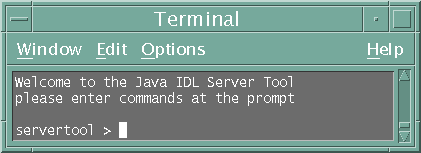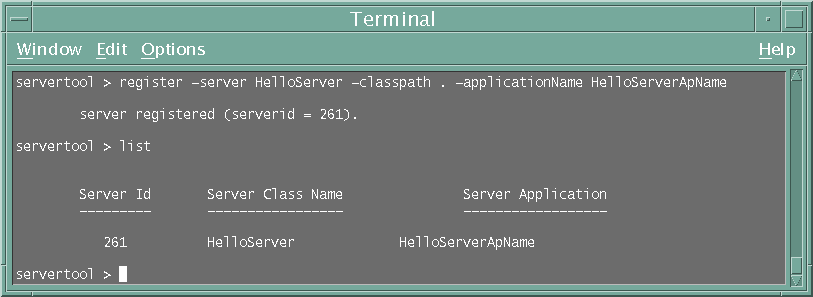orbd - The Object Request Broker Daemon
orbd is used to enable
clients to transparently locate and invoke persistent objects on servers in the CORBA
environment.
See also: Naming Service
SYNOPSIS
orbd <options>
DESCRIPTION
The Server Manager included with the orbd tool is used to enable
clients to transparently locate and invoke persistent objects on servers in the CORBA
environment. The persistent servers, while publishing the persistent object references
in the Naming Service, include the port number of the ORBD in the object reference
instead of the port number of the Server. The inclusion of an ORBD port number in the
object reference for persistent object references has the following advantages:
- The object reference in the Naming Service remains independent of the server life
cycle. For example, the object reference could be published by the server in the Naming
Service when it is first installed, and then, independent of how many times the server is
started or shutdown, the ORBD will always return the correct object reference to the
invoking client.
- The client needs to lookup the object reference in the Naming Service only once, and
can keep re-using this reference independent of the changes introduced due to server life
cycle.
To access ORBD's Server Manager, the server must be started using servertool, which is
a command-line interface for application programmers to register, unregister, startup, and shutdown a persistent server.
For more information on the Server
Manager, see the section in this document titled Server Manager.
When orbd starts up, it also starts a naming service. For more information
on the naming service, link to Naming Service.
REQUIRED OPTIONS
-
-ORBInitialPort nameserverport
- Specifies the port on which the name server should be started. Once started, orbd will listen for incoming requests on this port. Note that when
using Solaris software, you must become root to start a process on a port under 1024.
For this reason, we recommend that you use a port number greater than or equal to 1024.
(required)
OTHER OPTIONS
-
-port port
-
Specifies the activation port where ORBD should be started, and where ORBD will be
accepting requests for persistent objects. The default value for
this port is 1049. This port number is added to the port field of the persistent
Interoperable Object References (IOR). (optional)
-
-defaultdb directory
-
Specifies the base where the ORBD persistent storage directory orb.db is
created. If this option is not specified, the default value is "./orb.db". (optional)
-
-serverPollingTime milliseconds
-
Specifies how often ORBD checks for the health of persistent servers registered via servertool. The default value is 1,000 ms. The value specified for milliseconds must be a valid positive integer. (optional)
-
-serverStartupDelay milliseconds
-
Specifies how long ORBD waits before sending a location forward
exception after a persistent server that is registered via servertool is restarted. The default value is 1,000 ms. The
value specified for milliseconds must be a valid positive integer. (optional)
- -Joption
- Pass option to the Java virtual machine, where
option is one of the options described on the
reference page for the java application
launcher. For example, -J-Xms48m sets the startup
memory to 48 megabytes. It is a common convention for -J
to pass options to the underlying virtual machine.
A Naming Service is a CORBA service that allows CORBA objects
to be named by means of binding a name to an object reference.
The name binding may be stored
in the naming service, and a client may supply the name
to obtain the desired object reference.
Prior to running a client or a server, you will start ORBD. ORBD includes a persistent Naming Service and a transient Naming Service, both of which are an implementation of the COS Naming Service.
- The Persistent Naming Service provides persistence
for naming contexts. This means that this information is persistent across service shutdowns and startups, and is recoverable in the event of a service failure. If ORBD is restarted, the Persistent Naming Service will restore the naming context
graph, so that the binding of all clients' and servers' names remains intact (persistent).
- For backward compatibility,
tnameserv, a Transient Naming Service shipped with older versions of the JDK,
is also included in J2SE v.1.4. A transient naming service retains naming contexts as
long as it is running. If there is a service interruption, the naming context graph
is lost.
The -ORBInitialPort argument is a required command-line argument for orbd, and is
used to set the port number on which the Naming Service will run. The following instructions assume you can use port 1050
for the Java IDL Object Request Broker Daemon. When using
Solaris software, you must become root to start a process on a port under 1024. For
this
reason,
we recommend that you use a port number greater than or equal to 1024. You can substitute
a
different
port if necessary.
To start orbd from a UNIX command shell, enter:
orbd -ORBInitialPort 1050&
From an MS-DOS system prompt (Windows), enter:
start orbd -ORBInitialPort 1050
Now that ORBD is running, you can run your server and client applications. When running the client and server applications, they must be made aware of the port number (and machine name, if applicable) where the Naming Service is running. One way to do this is to add the following code to your application:
Properties props = new Properties();
props.put("org.omg.CORBA.ORBInitialPort", "1050");
props.put("org.omg.CORBA.ORBInitialHost", "MyHost");
ORB orb = ORB.init(args, props);
In this example, the Naming Service is running on port 1050 on host "MyHost". Another way is to specify the port number and/or machine name when running the server or client application from the command line. For example, you would start your "HelloApplication" with the following command line:
java HelloApplication -ORBInitialPort 1050 -ORBInitialHost MyHost
To stop the naming service, use the relevant operating
system command, such as pkill orbd on Solaris, or Ctrl+C in the
DOS window in which orbd is running. Note that names registered
with the naming service may disappear when the service is
terminated if the naming service is transient. The Java IDL naming service will
run until it is explicitly
stopped.
For more information on the Naming Service included with ORBD, see Naming Service.
To access ORBD's Server Manager and run a persistent server, the server must be started using servertool, which is
a command-line interface for application programmers to register, unregister, startup, and shutdown a persistent server. When a server is started using servertool, it must be started on the same host and port on which orbd is executing.
If the server is run on a different port, the information stored in the database for local contexts will be invalid and the service will not work properly.
Server Manager: an Example
Using the sample tutorial for our demonstration, you would run the idlj compiler and javac compiler as shown in the tutorial. To run the Server Manager, follow these steps for running the application:
- Start orbd.
To start orbd from a UNIX command shell, enter:
orbd -ORBInitialPort 1050
From an MS-DOS system prompt (Windows), enter:
start orbd -ORBInitialPort 1050
Note that 1050 is the port on which you want the name server to run.
-ORBInitialPort is a required command-line argument. When using
Solaris software, you must become root to start a process on a port under 1024. For
this
reason,
we recommend that you use a port number greater than or equal to 1024.
- Start the servertool:
To start the Hello server, enter:
servertool -ORBInitialPort 1050
Make sure the name server (orbd) port is the same as in the previous step, for
example,
-ORBInitialPort 1050. The servertool must be started on the same port as the name server.
The servertool command line interface appears:

- Start the Hello server from the servertool prompt:
servertool > register -server HelloServer -classpath . -applicationName
HelloServerApName
The servertool registers the server, assigns it the name of "HelloServerApName", and displays its server id:

The graphic above also shows the servertool listing all registered servers.
- Run the client application from another terminal window or prompt:
java HelloClient -ORBInitialPort 1050 -ORBInitialHost localhost
For this example, you can omit -ORBInitialHost localhost since the
name server is running on the same host as the Hello client. If the name server is
running
on a
different host, use -ORBInitialHost nameserverhost to specify the
host on
which
the IDL name server is running.
Specify the name server (orbd) port as done in the previous step, for
example,
-ORBInitialPort 1050.
- When you have finished experimenting with the Server Manager, be sure to shut down or kill the name server (orbd) and servertool.
To shut down orbd from a DOS prompt, select
the window that is running the server and enter Ctrl+C to shut it down.
To shut down orbdfrom a Unix shell, find the process, and kill it. The server will continue to wait for invocations until it is explicitly stopped.
To shut down the servertool, type quit and press the Enter key on the keyboard.
See Also


